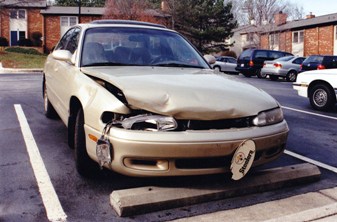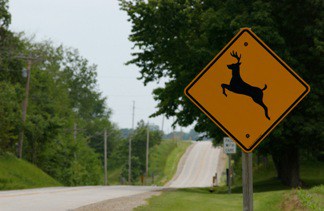How to Avoid Hitting a Deer with Your Car
From country roads to major interstates, deer have the potential to cause major damage to your vehicle.
Deer-car collisions rack up about $1 billion a year in costs, according to the National Highway Traffic Safety Administration. Some deer-collision insurance claims can reach $10,000, says Darrell Camilletti, owner of Mountain West Insurance & Financial Services, which has offices in Colorado and Arizona.
Comprehensive auto insurance coverage, which is optional, provides financial protection for deer-car collisions.

While auto insurance can ease the financial blow of a deer-car collision, it can’t alleviate the initial shock of a bumper-to-deer encounter. Here are stories from four motorists who were flustered by Bambi.
The late-night accident
Jon Page, 30, copywriter for a medical communications company
Where: Raleigh, N.C.
How it happened: Page was driving his 1995 Mazda 626 on a four-lane road about 2 a.m. “Just kind of out of the corner, I saw something streaking across the road. Before I had time to realize what it was, I swerved just a little bit to the left and braked. Before I knew it, it just slammed off the hood of my car.” Page, a student at North Carolina State University when the accident happened in 2002, drove a mile before stopping to call the police. “The car was still going, but I hadn’t gotten out yet to see how bad the damage was. When I got out, it was pretty clear.”
The damage: The greatest damage was to the hood and fender. “It looked like the hood was made out of tin foil and somebody came up and just pushed it into the headlight,” he said. The headlight shattered and was dangling by wires. The passenger-side wheel well also was damaged.
The coverage: His insurer, Nationwide, paid for the repairs after he forked over the $100 deductible.
Final thought: “If I hadn’t had swerved just a little bit, I wonder if I would have hit the deer head on and it would have come through the windshield. The damage obviously could have been much worse.”
The daytime collision
Ouida Bradford, 40, campus director, Chi Alpha Christian Ministries, Columbus State University, Columbus, Ga.
Where: Commerce, Ga.
How it happened: One afternoon in December 2006, Bradford was heading to Atlanta on a four-lane road. After she passed some farmland, she saw a doe and fawn running across a pasture. “It was the craziest thing because I didn’t even see them, and all of a sudden they were running along the fence line, jumped the fence and jumped in front of me.” The young deer bounced off her fender.
The damage: The 1997 Jeep Grand Cherokee Laredo was still running. She drove it to make sure there were no alignment problems and continued to her conference in Atlanta. The headlights and grill were replaced, and the hood was repainted.
The coverage: She called her insurer, State Farm, the same day and was given the name of a local body shop.
Final thought: “It was pretty hassle-free. Auto insurance is something that is relatively inexpensive to have, to know that in case something happens, you’re good.”
The totaled car
Elizabeth Quillen, 23, now working as an English teacher in Beijing, China
Where: Athens, Ga.
How it happened: Quillen, a student at the University of Georgia, was driving her 1992 Toyota Camry with three passengers around 7:30 p.m. in October 2010. “I turned left out of a parking lot about half a mile before I hit the deer. He jumped from the left side of the road, hit the hood, fell on the bumper and it felt like I drove over him.”

The damage: After she stopped, she discovered blood and hair caught in the bent metal and broken lights. She called her insurer, USAA, which gave her the number of an auto shop and paid for the car to be towed there. There was damage to the hood, headlights and bumper.
The coverage: The car was totaled, since the repairs cost about $2,000 — more than the value of the car. After talking to the auto shop, Quillen and her parents decided to pay for the repairs on their own. “They said the car was in very good condition other than the hood being bent up and unsafe.”
Final thought: “I did not know this until after the accident, but what I have been told since is that the best thing to do when facing a collision is to not swerve.”
The non-collision: Running over a deer
Richard Rodd, 58, financial planner
Where: Wolcott, Colo.
How it happened: Rodd was driving his 2009 Honda Civic Hybrid on Interstate 70 from Denver to Grand Junction, Colo., about 6 p.m. in December 2010 when a four-wheel-drive vehicle in front of him straddled the remains of a deer. “It’s not like a deer came out and hit me. The deer was run over several times before I ran over it. It was a pile of guts,” Rodd says. “Here I am at 65, 70 miles an hour, five cars length in back of him with both lanes filled. I couldn’t move to my right. My little Honda just went over it like a bump.”
The damage: The car’s heat went off, which warned him that the engine was in trouble. “I put it in neutral, and the next exit was several hundred yards down the road. I kind of coasted to it and didn’t try to stop the car. I got off the interstate ASAP.” In addition to a broken radiator, the front bumper was cracked and engine parts were marred, adding up to about $3,500 in repairs.
The coverage: Rodd’s insurer, Nationwide, covered the repairs; his coverage included a car rental.
Final thought: “I wanted the body shop people to be able to bring (the car) to me, if there was anything questionable. I said, ‘I want that replaced, I want that replaced,’ and they did. The (insurer) handled it beautifully.”
The 411 on deer collisions
Deer collisions are most common during October, November and December – deer mating and migration season – and they don’t just happen in rural areas late at night.
An estimated 1.09 million collisions between deer and vehicles occurred in the United States between July 1, 2010, and June 30, 2011, according to State Farm. Deer collisions decreased for the third consecutive year, but property damage is on the rise, with claims averaging $3,171, up 2 percent from the year before.
West Virginia is the state where a motorist is most likely to hit a deer, according to State Farm, followed by Iowa, South Dakota, Pennsylvania, Michigan, Montana, Wisconsin, Minnesota, North Dakota and Wyoming. It is important to get multiple free auto insurance quotes with coverage that will cover the costs of this type of collision.
Although deer-car collisions are most common at dawn and dusk, they can occur around the clock. They can happen in urban spots, too. For instance, researchers at the University of California, Davis, are tracking and capturing deer in an effort to reduce the number of deer being hit on Interstate 280 near San Francisco.
How to avoid a deer collision
Here are five tips on avoiding a collision with a deer, courtesy of State Farm and the Wisconsin Office of the Commissioner of Insurance:
- At night, use your high-beam lights as much as possible.
- Be aware of deer crossing signs, which are posted in areas where a lot of deer are found.
- If you see a deer on the road, slow down and blow your horn; another option is to flash your headlights.
- Don’t swerve, which could cause you to lose control of your vehicle. Instead, brake firmly.
- If you hit a deer, do not leave your vehicle. Move off the road and call the police.
